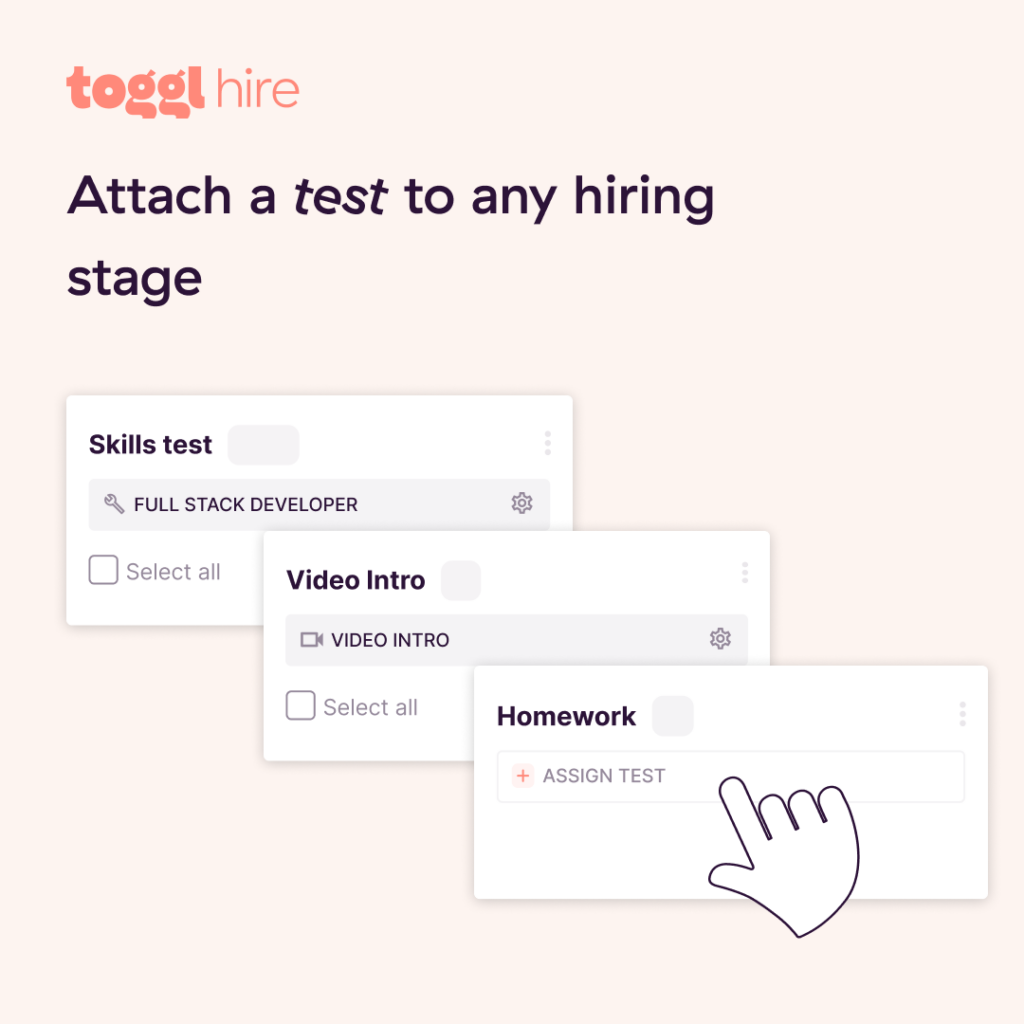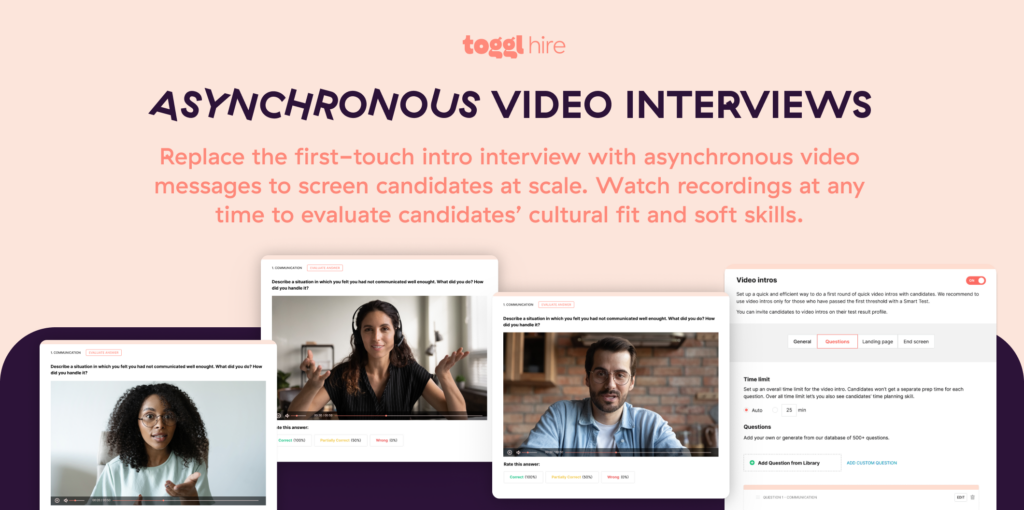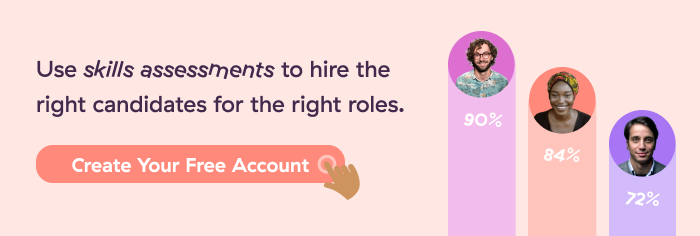Settling the debate of which is better, structured interview vs. unstructured interview, is pretty easy — it depends. 😉
Seriously, though, conducting job interviews is tough for any hiring manager. While you want to learn as much useful information about a candidate as possible to determine if they’re a good fit for the role, it’s also important to make the candidate feel comfortable opening up during the process.
So which type of interview is best? Again, it depends. As you prepare for your next round of interviews, it’s worth understanding the key differences between these approaches so you can determine which method might work best, given the role you’re hiring for, your company culture, and your candidate pool.
TL;DR — Key Takeaways
- Think of structured interviews like a quiz, where everyone gets the same questions. This makes it easier to compare apples to apples. Unstructured interviews are more like a casual chat over coffee — the conversation can go anywhere based on the candidate’s responses.
- Structured interviews are your go-to when you’ve got lots of applicants or need to measure specific skills. On the flip side, unstructured interviews are great for getting a feel for someone’s personality or problem-solving style. These are often used for senior roles or when you’ve narrowed down your list to a few top candidates.
- When should you use an unstructured interview vs. a structured interview? It all depends on what you’re looking for. If you need to compare lots of people or test certain abilities, go for a structured interview. But if you want to dive deeper into a person’s character or thought process, an unstructured interview is usually best.
- There are hiring tools out there that can help with both types of interviews. Toggl Hire, for example, has features like skills tests and candidate ranking for structured interviews and flexible question design for unstructured ones.
What is a structured interview?
Structured interviews consist of a pre-defined set of questions that are prepared in advance and asked of every candidate.
The hiring manager or HR department can use the answers and qualitative data to score the candidates and assess whether they will be a good fit for the role and if they should move up in the interview process.
“In a structured interview, well-trained interviewers ask a set of planned, rigorous, and relevant interview questions and use a scoring guide to make sure their interview ratings are accurate. Structured interviews are one of the best tools we have to identify the strongest job candidates (i.e., predictive validity). Not only that, they avoid the pitfalls of some of the other common methods.”
Dr. Melissa Harrell, a hiring effectiveness expert on the Google People Analytics team
The structured interview style is commonplace in corporate environments as a part of introduction calls from job recruiters and at the beginning of the hiring pipeline.
By implementing structured interviews, it’s easier to turn the interviewee’s answers into a binary assessment of their strengths and weaknesses.
Examples of a structured interview
It’s ultimately best to create your own structured interview questions. However, regardless of which questions you choose to ask in a structured interview, the goal is to ensure they provide you (or your hiring team) with insight into a candidate’s skills, experience, and suitability for the role.
Here are a few examples.
General Job Applicant Questions. These typically focus on skills and experience. For example:
- “Describe a time when you used your communication skills to resolve a conflict at work.”
- “Can you provide an example of a project where you had to use your problem-solving skills?”
Manager Level Questions. For managerial roles, questions often probe leadership style and handling team dynamics. A sample question might be:
- “Tell me about a time when you had to manage a team through a challenging situation. How did you handle it, and what was the outcome?”
What is an unstructured interview?
An unstructured interview is usually conducted in a more casual setting.
Unlike a structured interview, the unstructured interview doesn’t necessarily have a pre-defined list of questions. The interviewer has an idea of the type of candidate they need for the role and asks more open-ended, free-flowing questions.
This makes collecting unbiased data significantly more difficult. It also makes it much harder to compare candidates.
The types of questions in an unstructured interview can vary greatly, from asking candidates about their past employment to how they tackle complex situations.
The ‘bias’ issue with unstructured interviews
The open nature of an unstructured interview means that the hiring manager might immediately make the wrong decisions. After all, we make snap decisions and have an unconscious bias when meeting a new person.
This can greatly weigh against finding the perfect future employee and cost the company a fantastic new hire. Humans, after all, aren’t objective.
Examples of an unstructured interview
Remember, the goal of an unstructured interview is to let the conversation flow naturally, providing a comprehensive understanding of the candidate’s capabilities and fit for the role.
These questions do not follow a predefined pattern and are often more open-ended, allowing the interviewee to express their personality and soft skills more freely.
General Questions. Unstructured interviews often start with broad, open-ended questions such as:
- “Tell me about yourself.”
- “What led you to apply for this role?”
Experience-Based Questions. These might be more specific to the individual’s experiences, like:
- “Can you share a project that you’re particularly proud of?”
- “Describe a challenging work situation and how you handled it.”
Clarification Questions. These allow the interviewer to gain further insight and clarification based on the interviewee’s responses. For example:
- “You mentioned that you led a team in your previous role. Can you tell us more about how you motivated your team during challenging periods?”

When should you use a structured interview?
As mentioned earlier, the structured interview is more commonly adopted by growing organizations and established corporate entities.
For example, Google has an entire guide on how it uses structured interviews during its hiring process. It’s a great starting point when researching structured interview questions.

This type of interview is perfect when filling a role that has specific or technical requirements. For example, if you needed to find the exact piece of machinery to fit a highly sophisticated assembly line, you’d use a structured interview model.
You’d be better off opting for structured interviews when:
- You have a well-defined job description and know exactly what skills and competencies are needed on the job
- You need to fill the role promptly and want a fast, efficient hiring process
- You want to eliminate any type of bias from the hiring process
- More people are involved in the hiring process, and you know you’ll be comparing notes on candidates to make the final hiring decision
When should you use an unstructured interview?
The smaller your organization, the easier it is to utilize the unstructured interview format. For example, startups consisting of five or so people will waste time trying to put together a rigid interview process for a new hire.
By using an unstructured interview, it’s easier to fill jack-of-all-trades roles or add additional skills and knowledge to your growing business.
Unstructured interviews also make it easier for every person in the organization to ask their own interview questions without everyone being on the same page. It’s more time-consuming than structured interviews, but it’s also far less set in stone.
But…relying on unstructured interviews alone might lead to a bad hire. Remember, interviews are not great job performance predictors. We highly recommend combining them with structured skills assessments.
Unstructured questions in the late-stage interview
Unfortunately, an unstructured interview is not a good representation of a candidate’s future job performance (interviews, in general, when conducted without skills assessments or homework assignments, are rarely a good measure of job performance, honestly).
This is why the unstructured interview method is best left for the later stages of the hiring process. Once you’ve gathered enough data on the candidate, you can ask the interviewee a list of questions to better showcase their personality.
Interviewers will also have an easier time understanding the differences between various candidates after the initial round of structured questions.
Interviewing candidates through a conversation is an excellent way to explore their particular personal skills. Stakeholders and hiring managers generally handle this approach to confirm cultural alignment.
However, it isn’t easy to compare candidates when they answer unstructured questions. Candidate A might use examples of their previous work as an answer, while Candidate B answers with anecdotal or hypothetical responses.
And then we find ourselves right back to bias.
A hiring manager may already have a favorable opinion of the candidate and ignore how they answer the questions asked of them.
You’d be better off opting for unstructured interviews when:
- The position you’re hiring for is not clearly defined and can be shaped by the successful candidate
- You have a top-class HR leadership on board who knows how to control and minimize biases
- You’re using skills assessments to predict job performance and unstructured interviews to assess interpersonal skills
- You’re ‘following up’ on a structured interview to collect more qualitative insights
The pros and cons of structured vs. unstructured interviews
As you can see, each of these interview types has its pros and cons. It’s important to understand the best situations for implementing a structured and unstructured interview.
The benefits of structured vs. unstructured interviews
The structured interview method holds several advantages when it comes to assessing candidates, namely…
| Characteristics of a Structured Interview | Characteristics of an Unstructured Interview |
| Fixed set of questions | Free-flowing questions |
| Set amount of time given to every candidate | Long-winded answers |
| Fixed order of questions | Asking questions as you think of them |
| Fixed number of questions | Filling up the interview time |
| Improved interview experience for the interviewer and interviewee | Trying to ask and answer questions neither are prepared for |
| Close-ended | Open-ended questions |
| Accurate and relevant responses | Conversation |
The drawbacks of structured vs. unstructured interviews
However, structured interviews aren’t without their limitations, either.
| Structured Interviews | Unstructured Interviews |
| Cannot delve deeper into a candidate’s answers | Asking immediate follow-up questions |
| The structured nature can seem cold and unwelcoming | The casual nature of unstructured interviews |
| Interviewers can’t ask open-ended questions in structured interviews (unless they’re pre-planned follow-ups) | Interviewers can ask any types of questions they want |
| Interviewers get a limited glimpse into the candidate’s personality | It is easier to understand how candidates conduct themselves in an unstructured interview |
| Interviewers may not receive enough depth from an interviewee’s responses | Interviewers are free to deep-dive into a topic of interest |
Creating a structured, data-driven hiring process with Toggl Hire
Whether you’re a multimillion-dollar corporation or a small startup, when hiring, using data is the best way to find the perfect candidate for the job.
If you’re finding it tough to accurately assess candidates without introducing bias into the process, it’s high time you look for a tool that can help you create a completely structured recruitment funnel to make the process as easy as possible for your company.
Toggl Hire is built around making the hiring process as easy and data-driven for you as possible. You can pick structured assessment tests for any skill or role from our test library, for example, or create bespoke ones yourself.
Regardless of how you choose to use it, here are three tips for getting the most out of our recruiting tool to help you create fair interview processes that yield the results you’re looking for — a great candidate experience, faster time to hire, and the right employees on your team.
Tip #1. Clearly explain the interview process
Be transparent with the candidates and clear about the various stages of the hiring process you’ll put them through. This allows candidates to prepare for every stage of the interview process and know what to expect.
You don’t have to struggle with this alone, though. If you’re using Toggl Hire, we already have role-specific hiring flows that you can access.
Say you’re hiring a JavaScript developer. When you create a Job for a JavaScript developer, we will automatically generate a pipeline stage for a video test, homework assignment, and interview. You can then adjust those stages by attaching relevant tests or simply tracking the progress of your pipeline.

Tip #2. Use qualitative questions in the interview
Asking the interviewee brainteaser questions might make you, the hiring manager, feel smarter and self-satisfied during the interview, but it’s bad practice.
After all, there’s no correlation between general cognitive ability and insight problems like brainteasers.
Instead, we use data, research, and expert insights to create questions that assess the technical skills required on the job. These standardized questions greatly increase the results, whether they’re positive or negative, of a structured hiring process.
The goal? To help you find the most qualified candidate, not the best interviewer.
Tip #3. Conduct multiple structured interviews at once
Setting up and conducting an intro interview is a time-consuming process. But with asynchronous video intros, you can conduct multiple structured interviews with candidates simultaneously.
The nature of a structured pre-recorded interview allows for all candidates to receive the same questions. And the best part is that we have a pool of 500+ skill-relevant interview questions at the ready!
Unlike unstructured interviews, asynchronous video interviews will follow a set formula and don’t require face-to-face conversations in real time that consume the interviewer or interviewee’s time.
Once an interviewee has finished answering their questions, you can review pre-recorded video answers, add notes and share them with the rest of the hiring team. This way, it’s easy to go back and compare shortlisted candidates later in the process or have less biased internal discussions.

The verdict on structured interview vs. unstructured interview
Now that you know the difference between structured and unstructured interviews, the conclusion is obvious — they both have a place in the recruitment process when combined with skills assessments.
- Interviews can’t predict future job performance. Combining practical skills tests with structured interviewing techniques yields the best results in shortlisting the right candidates.
- The advantages of structured interviews include: more predictive validity, interviewers are happier and saving time, and candidates report having a better overall experience.
- The pitfalls of unstructured interviews: more informal by nature and, therefore, more prone to bias. Often tend to be less effective in comparably assessing candidates’ capabilities. Work well as a form of qualitative data collection after a structured interview has taken place.
Don’t leave your hiring success to chance. Get started with a standardized recruitment flow by leveraging pre-built skills assessments. Create your free account now.

Juste loves investigating through writing. A copywriter by trade, she spent the last ten years in startups, telling stories and building marketing teams. She works at Toggl Hire and writes about how businesses can recruit really great people.







